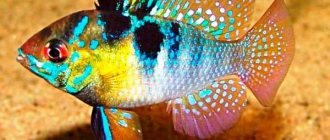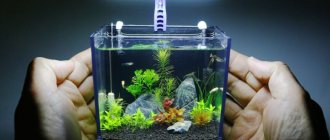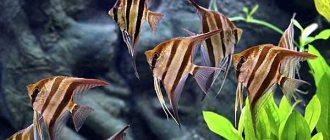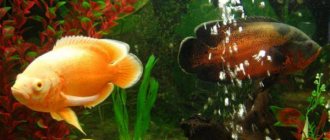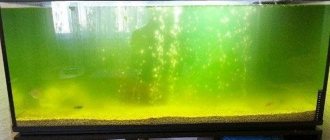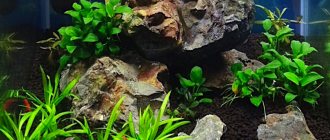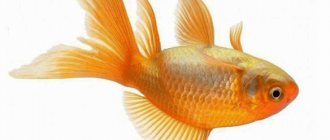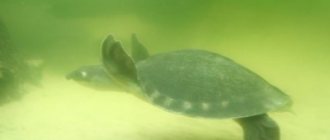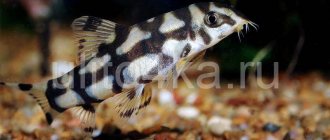Home » Our pets » Types of cichlids with descriptions, compatibility with other fish. How to maintain, what to feed and how to reproduce?
Today, breeding aquarium fish has become popular. An aquarium filled with representatives of the aquatic world is calming and relaxing.
One of the most popular and sought after aquarium fish is cichlids. They are unpretentious, friendly and disease resistant.
In the photo, cichlids look less colorful than in real life, so in order to see all the beauty of these aquarium fish, they should be placed at home.
Conditions and food
Cichlids can be wayward and peaceful. It depends on the group and species. Today there are many types of these fish. They range in size from 1 to 90 centimeters.
Keeping fish at home is carried out only in an aquarium with a volume of at least two hundred liters.
Terms and conditions of content:
- Water temperature ranges from 27 to 28 degrees.
- The water must be constantly aerated (saturated with oxygen).
- The water must be filtered.
Important! It is worth placing hard-leaved plants in the aquarium, because many feed on plant foods. The bottom of the aquarium is lined with flat stones.
The food is selected based on the species. The food changes periodically. Thus, herbivorous cichlids should occasionally be given animal food to improve their color and well-being.
African cichlids are prone to fights for food, so they should not be left hungry for long.
Dry food for this type of fish is selected with pigments that accumulate in the body and provide bright coloring.
Malawians are fed plant foods: chopped broccoli, zucchini, carrots, cucumber. Particular attention is paid to Utaki. Food with proteins is selected for them.
African cichlids should add spirulina (algae) in the form of flakes or granules to their diet. This component replaces fiber and affects the functioning of the digestive system.
Spirulina should not be overused. It is added once a week as a top dressing. If you overfeed your fish with it, they will develop spots on their heads.
Such fish must be given foods containing pyridoxine: shellfish, beef liver, egg yolk, bran, crustaceans.
It is forbidden to feed bloodworms and tubifex. Such food will cause damage to the mucous membrane.
Aquarium cichlids: maintenance and care rules
Cichlids are beautiful aquarium fish, with bright colors and high intellectual abilities. Every aquarist wants to add to the aquarium difficult and understandable fish such as mollies, guppies, cichlids and other viviparous fish that are not easy to care for. Aquarium cichlids are capricious and do not get along very well with fish. The maintenance and care of cichlids has its own peculiarities.
Description of the species
The cichlid families belong to the order Perciformes and are distinguished by a wide variety of colors and shapes. They can be small in length - 2 centimeters and quite large - up to 91 centimeters, and some specimens up to one meter. They are found in fresh and brackish water, in Asia, Africa, and Latin America. Some species are on the verge of extinction.
Answering the question “how long do cichlids live”, with proper care, life expectancy can reach up to 10 years. There are bred fish with bodies artificially colored in unnatural colors, for example, pink, but such pigment does not last long and the health of the fish deteriorates. .
Behavioral features
Peaceful cichlids are distinguished by their intellectual abilities; they remember the person who cares for them and can easily recognize him. The offspring are carefully cared for, the cichlid eggs and fry are protected from threats. Males get used to the female from childhood, so together they create a kind of mating pairs and also take care of the offspring together.
Look at the beautiful cichlid fish.
Variety of species
Breeders have managed to develop many different subspecies, differing in color and shape. As already mentioned, in addition to natural colors, there are also artificial ones. Breeders paint the scales of fish pink, green, and purple, which is harmful to health and requires proper keeping conditions. Species that are more common and can easily get along are angelfish, cichlids and discus. In total there are more than 1200 species of fish.
Content Features
To ensure living conditions and make life healthy and long, it is necessary to find out what living conditions are required for these creatures to get along.
- Availability of an aquarium with a capacity of more than 200 liters.
- Accurate adherence to temperature conditions; cichlid aquarium fish are extremely sensitive to temperature changes. The ideal temperature would be 27–28 degrees Celsius, and the water should be clean and enriched with oxygen.
- Availability of a filter and water aeration system for the aquarium.
- Once a week the water is partially changed.
- Each species living in a common aquarium must have its own shelter, so it is necessary to zone the aquarium with plants, stones, and other decorative elements. As well as the presence of caves, houses and other places where they can make shelters for weak cichlids and spend time.
- The lighting of the aquarium should not be too bright; moderate diffused light is sufficient.
- You can purchase cichlidariums, these are special ready-made aquariums for keeping a certain type of fish based on the requirements for care and maintenance, which can easily get along. After all, each variety of cichlids in an aquarium may have distinctive care requirements. Therefore, before buying fish, it is better to consult a specialist.
How to feed
What to feed these fish depends on what species you are interested in. Most species are omnivores; dry or frozen food is suitable for them; special minced meat can be used. Pamper the herbivorous inhabitants with plant food, otherwise they will begin to eat the live plants with which the aquarium is decorated. The main thing is that feeding should not be monotonous food, the diet should be balanced, it will be different for each species.
Reproduction
The males of this fish species are larger than the opposite sex and have a bright color that changes during spawning. They have a fat pad on their head, and their fins are powerful and developed. Females also change color during spawning.
If you want your fish to reproduce, under no circumstances should you remove cichlids for breeding that do not get along with each other or are not ready to spawn. Cichlids are smart fish, so if something doesn’t suit their partner or living conditions, they don’t reproduce. Important! If the fish is not ready to reproduce or the pair that was separated does not like each other, then fights are possible, up to the death of one of the fish, usually the female.
To give the fish an additional incentive to breed cichlids, use special food and try paired combinations. For spawning, a separate aquarium of up to 200 liters is prepared, in which the conditions for keeping cichlids will be met.
Species of these fish lay their eggs on flat surfaces, mainly stones, or in holes or caves. Some species lay and incubate eggs in their mouths. Parents do not leave eggs and fry unattended, monitor their safety, feed and raise the offspring themselves. Aquarium owners must take care of special food for the fry at home, this can be crustaceans and small plankton. You need to feed the fry often, but little by little.
Common diseases
In an aquarium, cichlids are strong and hardy, they have good immunity, but even so they can get sick, more often due to improper housing conditions, poor-quality food, and non-compliance with temperature conditions.
- Fish louse, or ichthyophthyriosis, is the most common disease. Signs: compression of the fins and scratching of the fish on the ground and other surfaces, a white coating covers the body. Cause of the disease: parasitic equiciliate ciliates.
- Saprolegniosis is the second most common disease. Signs: a fungus appears that looks like a piece of cotton wool.
The fish must undergo a course of treatment; it is better to place them in a quarantine aquarium until complete recovery.
Who do they get along with?
This type of fish is capricious and zealously guards its territory. Even with other fish of its own species it is not easy to get along; it is better to provide each formed group of cichlids with its own space in the aquarium, using zoning. Poor compatibility with small, modest and calm fish such as guppies or aquarium goldfish. Different species behave completely differently with the same neighbors, so you need to think carefully and thoughtfully about who to share your characteristic fish with.
When purchasing cichlids, you should definitely learn how to properly care for them, what kind of food they need, and what the aquarium and its components should be like. You need to find out what diseases the fish have, what kind of neighbor they get along with, then these wonderful and beautiful pets will delight you for a long time and will become a real decoration of the aquarium. Aquarium science involves answering questions about the content.
Video about cichlid fish
ribnydomik.ru
Reproduction and offspring
Most of the species of representatives of this aquatic world live in lakes and reservoirs of Africa, Latin America and Asia.
During the breeding season, aquarium fish change color to a brighter and more saturated one. The eggs are laid by females in sandy cavities. Some species of fish carry future offspring in their mouths.
Breeding rules:
- During the spawning period, cichlids are placed in separate aquariums. But if the female is not ready to reproduce, the males kill them.
- After the fry are born, they should be moved to another aquarium. Adults carefully protect their offspring, so fights arise among them, in which the fry can get hurt.
Content Rules
To ensure that your cichlids are always healthy and energetic, you need to follow the following tips from experienced aquarists regarding their maintenance:
- the container where the cichlids will live must have a volume of at least 150 liters, and preferably more than 200 liters;
- diffused light is desirable for lighting;
- You should definitely install filters and a water aerator;
- Every week you should clean the container and change the water in it;
- Cichlids cannot tolerate low water temperatures, so it should always be kept at +28°C.
These fish love to hide and dig holes, so it is recommended to use coarse sand as soil and decorate the bottom with artificially created grottoes, caves, and rock slides.
Names of species and their descriptions
Cichlids are classified based on their habitat.
Note! Today there are 1,300 species of representatives of the Cichlid family. They differ from each other in size and color.
Groups of data from representatives of the water world:
- Malawian.
- Dwarf.
- African.
Malawian fish are classified into two groups: mbuna and utaka.
The first groups of representatives of the aquatic world live in places with a rocky bottom and dense vegetation. Mbuna males scrape vegetation from rock surfaces with grater teeth.
The second group includes fish - predators that inhabit reefs in nature. They feed on fry. In the aquarium, they should be fed with animal food.
Fish of the utaka group are larger in size. Both species cannot be placed in the same aquarium.
Dwarf fish are small in size and unpretentious. Typically, dwarf cichlids do not exceed 14 centimeters in size. They do not dig the soil, are peaceful, and cause minimal harm to plants.
The largest number of species is concentrated in Lake Tanganyika. This lake is characterized by hard, clear and alkaline water.
Table: common types of other fish
| Name | Description |
| Cichlazoma black-striped | Cichlazomas are distinguished by a compacted shell, an elongated body and flattened sides. The fish has a large mouth and bulging eyes. Cichlasomas have fast regeneration; they quickly recover from damage to their scales. Most fish species are black |
| Discus | Discus fish are large striped aquarium fish. This is a South American species that quickly adapts to life in an aquarium. The size ranges from 15 to 25 centimeters, the body shape is disc-shaped. There are many varieties of discus, but the most popular ones are: green, red, and turkis. Discus fish have weak immunity and capricious temperament. |
| Angelfish | The fish reaches 15 centimeters in length and 25 centimeters in height. The body is disc-shaped. Feature: long vertical fins |
| Red parrot | Representatives of this species are up to 25 centimeters in size. The fish has a severely deformed spine and a triangular mouth. The lips usually do not close. There are yellow, orange, red, blue, white varieties of these fish |
| Akara | Akara has a unique mother-of-pearl color. Akaras are very smart and calm. They can often be seen near the glass of an aquarium, inactive. |
| Labidochromis yellow | This species easily survives diseases and is highly resistant. Labidochromis yellow come in different shades: from blue to turquoise and from yellow to gold. The fish lives on average from 7 to 8 years, adapts normally in the aquarium |
| Flamingo | The most picky type of cichlids. The length varies from 8 to 15 centimeters. The fish got this name due to its soft pink color. Flamingos are worth getting for beginner aquarists. An aquarium with a capacity of 50 liters, with fine gravel laid on the bottom, is suitable for keeping. |
| Flower Horn | This species appeared as a result of hybridization. Anatomically, males and females are different. Males have a high forehead in the form of a hump, and long braids on their fins |
Description of the appearance of the fish
The family includes 1300 species . In nature, these beautiful fish live in the waters of Asia, Africa and South America. They range in length from 2 to 91 cm.
The fish are characterized by an oval (less often round) body, which is slightly compressed from the sides. The mouth is wide with roller-shaped teeth. In males, on a large head, the forehead protrudes strongly forward. The dorsal and anal fins are slightly elongated, the lateral line is incomplete. With proper care, these fish can live in an aquarium for quite a long time.
Artificially colored specimens in pink, purple and green are also available. But these are dyes of chemical origin and will fade very quickly. And the health of these fish will be significantly weakened.
Compatibility with other fish
Many species of cichlids are moral, so it is difficult for them to get along in the same territory with other representatives of the aquatic world.
Predators are kept only in separate containers. Cichlids do not get along well with astronotus and botia.
What fish should you not keep cichlids with:
- Som.
- Gourami.
- Guppy.
- Pecilia.
- Mollies.
- Sword bearers.
Important! In terms of compatibility, cichlids live well with schools. But the flock moves in during the period when the cichlids are still fry.
Attention should be paid to Labidochromis yellow. This species gets along with cockroaches, corydorassas and ancistruss.
Useful video
Share this post
- Related Posts
- What to do if a cat has watery eyes: causes and methods of treatment?
- Is it possible to keep lemurs at home and what should be their care?
- Review of dogs that look like bears
- Features of breeding neon fish at home
- How to keep aquarium fish, why they get sick, unpretentious species and their compatibility
- What you need to know about Pekingese dogs, how to care for them at home?
Limited compatibility
Not very good compatibility with Cichlid representatives:
- Types of cichlids with different temperaments. If you add Melanochromis Johan to the Auratus, then the probability of peaceful coexistence will be 50%.
- Small cichlids are sometimes compatible with small underwater inhabitants (swordtails, iris).
- Botsiya.
- Astronotus (with individual species of approximately equal size).
- Barbs (with equal sizes or with a slight difference).
All species of Cichlids have limited compatibility with other fish, provided that they grew up together from the age of fry or young fish. In this case, situations are known where even the most aggressive species coexist quite peacefully with neighbors that are unsuitable for them. But such settlement is possible only for young representatives. As adults, Cichlids become more aggressive and are suspicious of all strangers.
Cichlid breeding
The most interesting thing about keeping aquarium cichlid fish is related to their breeding season. This also includes mating games, when the male shows off in front of the female and drives away competitors. The spawning process itself and the subsequent care of the eggs and fry are also interesting.
Each species has its own reproductive characteristics, but without exception, all of them take care of their offspring, albeit until a certain time. Thus, when angelfish lay eggs on a plant leaf, they fan it with their fins, removing unfertilized eggs. Many species do the same, the only difference is in the place where eggs are laid (many species do this in shelters).
But there are other methods of reproduction - a number of species incubate eggs in the mouth. Many African cichlids reproduce in this way; aquarium fish that are native to this region are usually kept in separate biotope aquariums. So, having laid the eggs and waited for them to be fertilized by the male, the female collects them in her mouth and keeps them there until the fry emerge. At this time, she does not eat and can lose a lot of weight, but she ensures high survival rate of the offspring.
It may be even more interesting - some species raise their offspring together in this way, transferring eggs to each other during feeding. After the fry emerge, the parents continue to care for them, and, in case of danger, hide the fry in their mouths. They also control the behavior of the fry by giving them signs with their fins and body movements.
Feeding cichlids
The diet of cichlids should be varied, and in no case should they be fed only dry food, even from well-known manufacturers. The diet should contain live food, albeit frozen (bloodworm, tubifex, daphnia, etc.).
Also among cichlids there are species that in nature feed mainly on plants and algae. In this case, herbal supplements are included in their regular menu; without this, their full color and reproduction are impossible.
Large aquarium cichlid fish can also eat pieces of meat, earthworms, and small live fish. In particular, astronotus are usually fed with small species of aquarium fish discarded from breeding.
